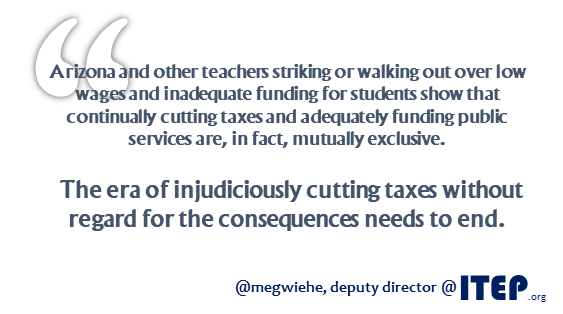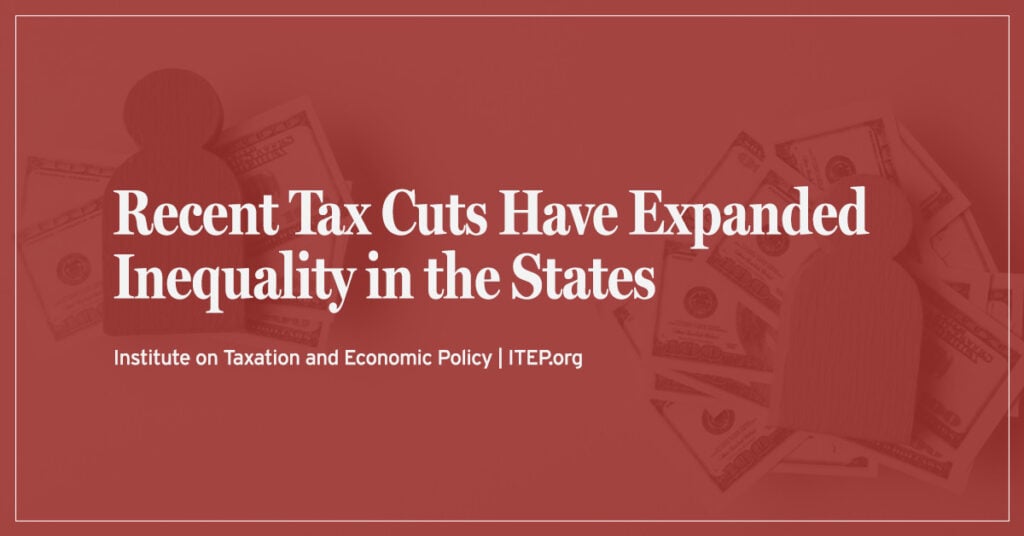In 2018, Arizona teachers took part in a national wave of teacher walkouts, protesting inadequate education funding and some of the lowest teacher pay in the nation—direct results of the state’s penchant for deep tax cuts and its decision to levy some of the lowest tax rates in the country on high-income families.
Two years later, in November 2020, Arizonans approved a tax surcharge on the state’s top 1 percent of earners, raising nearly a billion dollars per year to reverse the damaging cuts to education that have harmed low-income and rural communities most. Barely six months after that, interest groups and lawmakers in the state are pursuing an aggressive two-prong strategy to wipe out most, or all, of the tax increase approved by Arizona voters as Proposition 208. Plan A is to ask the state Supreme Court to throw out the vote on the grounds that it spends too much on educating Arizona’s children. If that effort falls short, Plan B is for lawmakers to negate the measure with an unprecedented, regressive tax bracket overhaul that would allow many high-income Arizonans to pay even lower taxes than before the ballot measure passed, which would reduce overall revenues dramatically. This article walks through the details of Plan B.
Using the ITEP tax model, we estimate that under Proposition 208 the top 1 percent of Arizona households, with an average income of about $1.5 million, should pay an additional $23,000 per year in state income taxes. Based on our understanding of the legislature’s current proposal, as explained in the media and by its supporters, the plan is to wipe out the $23,000 tax increase for most families and transform it into a nearly $3,000 average tax cut for the rich instead.
The result would be an $800 million annual revenue loss relative to the tax law as it existed before Arizonans made their voices heard in November, or a $1.6 billion revenue loss relative to the tax structure that exists today. Depending on the details, some of that loss could be compounded by a provision in the most recent federal rescue package that claws back fiscal aid from states that attempt to use the money to pay for tax cuts. Supporters of the Arizona plan claim they will hold education funding constant in the face of this steep revenue decline, but the fiscal pressure created by these tax cuts will inevitably find its way into the state’s education investments and other critical areas of the budget.
The details of the legislature’s tax overhaul are being worked out in secret, and the House minority leader predicts that the details may not be made public until 24 hours before the vote. But here’s what we know so far:
The starting point of the plan is to replace the state’s basic tax rate structure, with rates ranging from 2.59 to 4.5 percent of taxable income, with a single income tax rate of just 2.5 percent instead.
When combined with the 3.5 percent surcharge approved by voters, one would expect this to result in a top rate of 6 percent. But this does not seem to be what lawmakers have in mind. Capitol Media Services in Arizona reports that lawmakers are also working on a plan to “let some high-income families escape the 3.5% income tax surcharge approved by voters.” Grover Norquist of Americans for Tax Reform, a supporter of the plan, explained that this would be done by introducing “an aggregate cap to ensure the effective top rate is not higher than 4.5%.”
The mechanics of how a cap on the effective top rate would work are unclear, but the most generous interpretation of Mr. Norquist’s statement is that no taxpayer would pay more than 4.5 percent of their taxable income in state income tax. (The alternative interpretation is that the marginal tax rate applied to any dollar of income would not exceed 4.5 percent—an interpretation that would result in even larger revenue losses and even larger tax cuts for the very wealthiest people in the state.)
To realize the 4.5 percent tax cap described by Mr. Norquist, the plan would need to pair the voter-approved surcharge with the nation’s only regressive personal income tax structure. At incomes above roughly $1.2 million for married couples (or $600,000 for singles), the marginal tax rate under the base income tax structure being considered by the legislature would plummet from 2.5 percent to 1 percent. This would keep the overall tax rate (including the voter-approved surcharge) below 4.5 percent of taxable income.
Viewed on its own, this kind of upside-down rate structure is indefensible policy. It serves only one purpose: to negate the 3.5 percent rate increase approved by the voters. The legislature’s plan, when all is said and done, is to return the top marginal tax rate on extremely high-income earners to 4.5 percent, precisely the level that Arizonans decided was too low when they approved Proposition 208. The state’s Voter Protection Act, which prohibits lawmakers from undermining measures approved by voters, should prevent this sabotage (even Proposition 208’s opponents conceded this point as recently as November of last year). But the Arizona Supreme Court, which has a track record of hostility toward progressive tax reform, will make the final decision on how that Act will be interpreted in this instance.
High-income Arizonans would receive significant tax cuts under this plan. Relative to the tax structure that exists today, a married couple with $2 million of taxable income would receive a $50,058 tax cut. Put another way, the $52,500 tax increase they had been scheduled to face under Proposition 208 would be whittled down to a mere $2,442 instead—or barely one-tenth of one percent of their taxable income.
For many top earners, this plan would go even further and would actually cut taxes relative to the system that existed before voters approved a tax increase last November. A married couple with $700,000 of taxable income, for example, could have expected to face a $7,000 tax increase under Proposition 208. This plan would wipe that out and replace it with a $4,558 tax cut instead. The net result would be a $11,558 tax cut relative to law as it exists today.
Compared to the tax structure that existed prior to last November, 85 percent of the tax cuts paid out under this plan would flow to the top 20 percent of earners. Roughly half (50 percent) would flow to the top 5 percent alone, a group with incomes in excess of $224,000 per year.
Compared to the more progressive tax structure that Arizonans approved last year, the lopsided distribution of the tax cuts is even more dramatic. More than 9 in 10 dollars (92 percent) would flow to the top 20 percent of earners, with most of that reserved for the families at the very top. Three quarters (74 percent) of the tax cut would go to just the top 5 percent of families and more than half (53 percent) would go to the top 1 percent alone.
Top earners in Arizona are overwhelmingly white – a reality created through years of racism and discrimination throughout all segments of society. As a result, the distribution of tax cuts under this plan would also be heavily focused on white families. Just 4 percent of families in Arizona are white, non-Hispanic with income above $224,000. And yet this group would receive 59 percent of the total tax cuts envisioned under this plan. The average white family would receive a tax cut more than twice as large as the average Hispanic, Indigenous, or Black family. In other words, this legislation would worsen the extreme racial disparities in income that already exist in Arizona.
In November, Arizonans voted for more revenue and higher taxes on the rich. Now, the legislature is contemplating replacing that reform with a rewritten tax bracket structure that would produce less revenue and lower taxes on many of those high-income families. The disconnect between Arizonans and their elected officials couldn’t be starker.





